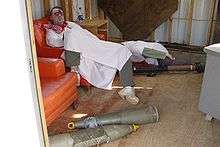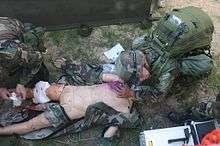Moulage

Moulage (French: casting/moulding) is the art of applying mock injuries for the purpose of training Emergency Response Teams and other medical and military personnel. Moulage may be as simple as applying pre-made rubber or latex "wounds" to a healthy "patient's" limbs, chest, head, etc.,[1] or as complex as using makeup and theatre techniques to provide elements of realism (such as blood, vomitus, open fractures, etc.[2]) to the training simulation. The practice dates to at least the Renaissance, when wax figures were used for this purpose.[3]
In Germany some universities and hospitals use their historical moulage collections for the training of students. The often very lifelike models are especially useful to show the students today the characteristics of rare diseases, such as skin tuberculosis or leprosy.[4]

History
In the 16th century, European scientists had a little knowledge of about human anatomy and anatomy of animals. Medical students of Bologna and Paris studied the books of the Aristotle, Galen (Greek physicians), and other Greek scholars. Four centuries after the invasion the Arabs and the fall of Rome and Persia, many Greek books translated to Arabic language . Again European scientists translated these Arabic books in Latin and Greek languages,this process in medical field, made a renewing period for Galen authority in European countries. So in European medical schools the professors of anatomy was merely a lecturer of Galen books without any dissection of human body and Galen’s books was only way for learning of anatomy.because from the professors of anatomy point's of view always all medical ways ended to Galen books.
Andreas Vesalius (1514-1564) a Flemish anatomist at first was “ Galenist” at the University of Paris. When he migrated to Italy and entered to the University of Padua, he began dissecting of the human bodies he studied many details of human anatomy, he founds that Galen has anatomical mistakes, for example: Galen has written sternum has 7 segment but Andreas Vesalius found it had 3 segments. Galen writes that the bone of arm is longest bone in the human body, but Vesalius found that the bone of thigh is the longest bone in human body . At age 25 Andreas Vesalius found that anatomical knowledge of Galen is related to animal anatomy and therefore Galen had never dissected a human body . Vesalius In 1543 wrote an anatomical masterwork named in Latin: De humani corporis fabrica libri septem, (Latin for "On the fabric of the human body in seven books"), or in short : De Fabrica. Vesalius puts in this book the drawing pictures that show of human females and males that their skins was dissected.[5] In an exhibition in the 2014,the 500th anniversary of Vesalius’s birth, a copy of De fabrica prominently featured.[6] These pictures greatly influenced future anatomical wax models. So anatomical pictures of Vesalius followed by Veslingius, and Fabricius. by 1600, Fabricius had gathered 300 anatomical paintings, he made an anatomical atlas which named the Tabulae Pictae. Casserius, Spighelius, Harvey and Veslingius are other followers of Andreas Vesalius pictures . the Tabulae of Eustachius (1552), printed in 1714, has major effects in history of anatomical wax models.This works affected Pope Benedict XIV, so he issued a sentence for construction of a museum of anatomy in Bologna In 1742, named Ercole Lelli with anatomical wax models. Felice Fontana made cadaveric specimens wax models by the casting method for anatomical teaching.[7]
The history of wax models is ancient. Wax anatomical models were first made by Gaetano Giulio Zummo (1656–1701) who first worked in Naples, then Florence, and finally Paris, where he was granted monopoly right by Louis XIV. Later, Jules Baretta (1834–1923) made more than 2000 splendid wax models in Hospital Saint-Louis, Paris, where more than 4000 wax models were collected. While wax models were being made, he made pleasant conversations with the patients, sang songs or at times played the piano. Moulages were made for the education of dermatologists around the world, but were eventually replaced by color slides.
Wax sculpture, use in moulage
The modeling of the soft parts of dissections, teaching illustrations of anatomy, was first practised at Florence during the Renaissance. The practice of moulage, or the depiction of human anatomy and different diseases taken from directly casting from the body using (in the early period) gelatine moulds, later alginate or silicone moulds, used wax as its primary material (later to be replaced by latex and rubber). Some moulages were directly cast from the bodies of diseased subjects, others from healthy subjects to which disease features( blisters, sores, growths, rashes) were skilfully applied with wax and pigments. During the 19th century, moulage evolved into to three-dimensional, realistic representations of diseased parts of the human body. These can be seen in many European medical museums, notably the Spitzner collection currently in Brussels, the Charite Hospital museum in Berlin and the Gordon Museum of Pathology at Guy's Hospital in London UK. A comprehensive book monograph on moulages is "Diseases in Wax: the History of Medical Moulage" by Thomas Schnalke (Author) the director of the Charite Museum and Kathy Spatschek (Translator). In the 19th century moulage was taken of medical patients for educational purposes. The prepared model was painted to mimic the original disease. Nowadays anatomicals model are an important instrument of education of human anatomy in department of anatomy and biological sciences in medical schools.[8]
See also
References
- ↑ http://www.healthysimulation.com/shared/drexelmoulage.ppt The Art and Science of Moulage - Medical Simulation
- ↑ http://casemed.case.edu/simcenter/resources/moulage.cfm Moulage
- ↑ http://www.unmc.edu/news.cfm?match=12171
- ↑ http://www.uke.de/kliniken/hautklinik/index_16962.php
- ↑ http://evolution.berkeley.edu/evolibrary/article/history_02Comparative Anatomy: Andreas Vesalius
- ↑ http://www.news.utoronto.ca/u-t-acquires-annotated-copy-vesaliuss-great-anatomical-bookU of T acquires annotated copy of Vesalius's great anatomical book
- ↑ Alessandro Riva, Gabriele Conti, Paola Solinas and Francesco Loy .The evolution of anatomical illustration and wax modelling in Italy from the 16th to early 19th centuries. J. Anat. (2010) 216, pp209–222, doi: 10.1111/j.1469-7580.2009.01157.x
- ↑ Wax sculpture#Use in moulage
External links
| Wikimedia Commons has media related to Moulage. |
- http://www.moulagen.de/sammlungen/ International Overview of moulage collections of the Charité Berlin
- Museum of Moulages, University of Zurich (English/ German)
- Jacobi, Eduard (1913) [1903]. Atlas der Hautkrankheiten [Atlas of Skin Diseases] (in German) (5th ed.). Berlin: Urban & Schwarzenberg. OCLC 250681193.
- "Search Our Collection". Museum of Health Care. Retrieved December 3, 2011.
- Gordon, Ken (December 3, 2011). "OSU clinical instructor crafts simulated injuries, giving nursing students a more realistic look at trauma". The Columbus Dispatch. Retrieved December 3, 2011.